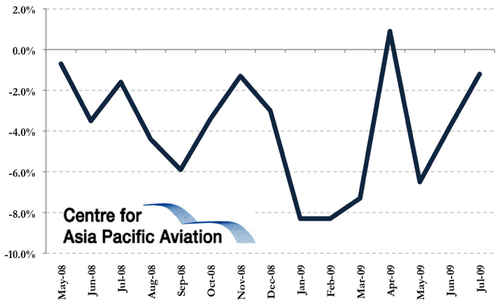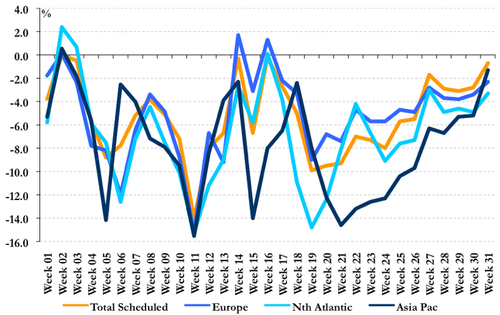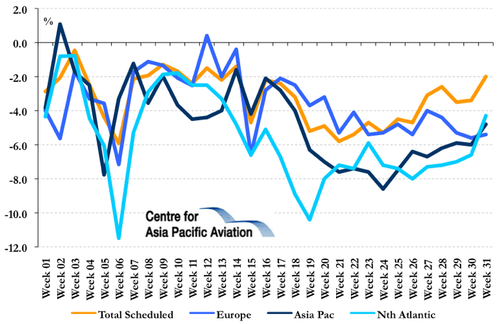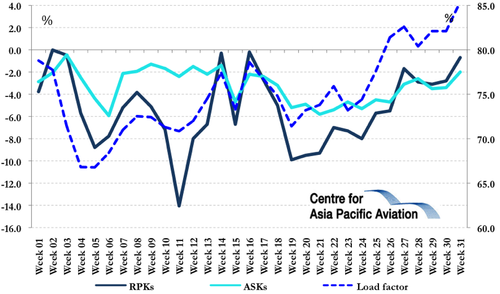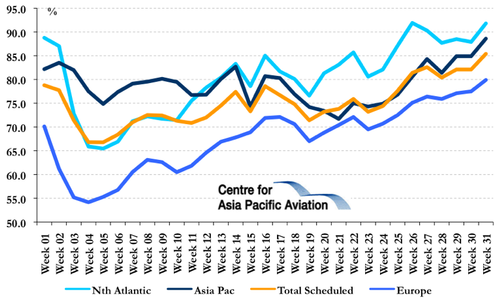European full service airline traffic ticks back up
After several weeks of near stability, both passenger traffic and airline capacity for Europe's airlines has ticked back towards positive territory. Although airline CEO and consumer confidence are still lingering in the doldrums, passenger traffic has made another leap towards breaking back into growth, on the back of persistent discounting and heavy competitive influences.
Europe's full service carriers are still suffering financially, with Austrian Airlines recently reporting an EUR84.6 million loss in 2Q2009 and British Airways losing GBP106 million in the same period.
However, traffic does appear to be making progress towards recovery, at least for some carriers. During Jul-2009, Air France-KLM's passenger traffic was down just 4.5% and British Airways traffic fell just 1.2% (the smallest decrease since May-2008, excluding the one-off effect of the late Easter in Apr-2009).
British Airways passenger traffic (RPKs) growth: May-2008 to Jul-2009
Still, while some major carriers are improving, other full service airlines are not witnessing the same recovery. Finnair's traffic was down 6.2% in Jul-2009, while SAS Group passenger traffic was down 14.1%.
Yields still remain under considerable pressure and are expected to remain weak at least for the remainder of 2009. British Airways noted last week that continued yield uncertainty will make revenue forecasting difficult.
A kick-up in passenger traffic
For the week ended 31-Jul-2009 (Week 31) scheduled traffic (RPKs) for member carriers of the Association of European Airlines (AEA) declined just 0.7% year-on-year, the smallest fall for almost four months.
Association of European Airlines' weekly passenger traffic (RPKs) growth (% change year-on-year) by region: First 31 weeks of 2009
Foremost among the passenger resurgence was traffic to/from the Asia Pacific region, which fell by just 1.3% during Week 31, compared to a 5.2% fall in the previous week. This is the best performance for Asia Pacific traffic since early Jan-2009.
North Atlantic traffic was down 3.3% (compared to -4.9% in Week 30), the smallest fall since the Easter holiday period. European traffic also improved, down just 2.3% - again the best weekly result since Easter.
Capacity cuts
Capacity cuts continue to slow, with a major retardation of cuts on long-haul sectors. Overall AEA members reduced capacity by 2.0%.
Association of European Airlines' weekly passenger traffic (ASKs) growth (% change year-on-year) by region: First 31 weeks of 2009
Intra-European capacity levels were reduced by 5.4%, remaining broadly in the -4% to -6% bracket seen over the past four months. However, ASKs to Asia Pacific markets were down 4.8% (compared to 6% in Week 30) and North Atlantic capacity was down 4.3% (compared to 6.6% in Week 30).
Balanced against the resurgence in capacity is the fact that demand continues to improve ahead of capacity, and has done so now for more than a month for Europe's full service carriers.
AEA member carriers RPKs, ASKs & load factors: First 31 Weeks of 2009
Load factors climb as well
AEA load factors have repeated the performance of demand, picking back up after several weeks of stability. Overall total scheduled load factors were 85.2%, with all regions hitting yearly highs.
Association of European Airlines' weekly passenger load factor by region:
First 31 weeks of 2009
North Atlantic load factors were above 90% again, with AEA members reporting an average of 91.8%. Asia Pacific load factors were 88.6%, while European average load factors are approaching 80% for the first time, hitting 79.9%. European load factors continued their incremental climb, hitting 77.4%.
Outlook: Winter test to be harsh
But a return to growth and a return to profitability are different matters. The best AEA members can hope for is a mild economic recovery by late 2009/early 2010, although the upcoming Winter is still expected to be a desperate time for many.
See related article: Ryanair looks to Italy for growth, Alitalia to transform Air One into an LCC
